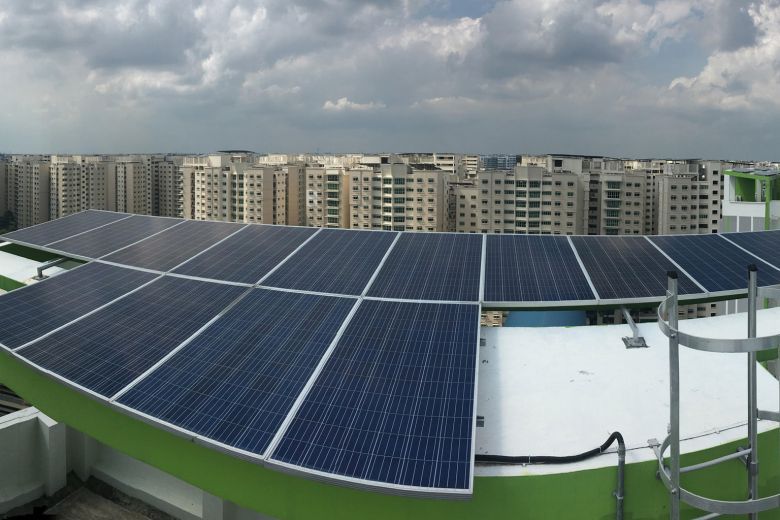HDB looking at expanding use of floating system for solar panels in open sea
Sign up now: Get ST's newsletters delivered to your inbox

Solar panels at Punggol Edge, where the pilot for solar-ready roofs began. The Housing Board announced that it will be signing a research collaboration with a landscaping firm in the coming week for the study and development of a floating solar system for coastal marine conditions.
PHOTO: HDB
Follow topic:
SINGAPORE - In land-scarce Singapore, the quest to harvest more energy from the sun will soon go one step further.
The Housing Board (HDB) - one of the agencies leading the nation's efforts to ramp up solar energy use - is setting its sights on a novel area of research: the sea.
On Sunday (July 8), HDB announced that it will be signing a research collaboration with a landscaping firm in the coming week for the study and development of a floating solar system for coastal marine conditions.
The study, said HDB, would see how its floating system can withstand harsher environmental conditions in the sea, such as stronger winds and wave action.
HDB chief executive Cheong Koon Hean said that over the past decade, the agency has been spearheading solar initiatives and accelerating solar adoption in Singapore.
For example, solar panels have been installed or are being fitted in more than 2,400 HDB blocks across Singapore. By 2020, about 5,500 HDB blocks will be fitted with or identified for solar installation.
The energy generated by these panels usually go to common services such as lifts, water pumps and lighting for common areas.
More than 95 per cent of Singapore's grid energy comes from the burning of natural gas.
Though natural gas is considered the cleanest form of fossil fuel, its combustion still contributes to the production of greenhouse gases.
Renewable energy from the sun, however, would reduce Singapore's reliance on fossil fuels. Its use is also in line with the Republic's target to reduce greenhouse gas emissions.
But considering Singapore's small land area, there is a limit to how much renewable energy from the sun can be harvested from solar panels installed on land.
"One way to further harvest Singapore's solar energy is to look beyond the sky to the sea. This is a practical approach, considering Singapore's land constraints," Dr Cheong said.
HDB's floating modular system, first tested in 2011 at a man-made waterway in Punggol to hold wetland plants, was subsequently deployed to hold solar panels at a solar panel test bed in Tengeh Reservoir in Tuas in May this year.
The latest research agreement, which HDB will sign with ISO Landscape during the World Cities Summit, a sustainability conference this week, will look at how the HDB-designed floating modular system can hold solar panels in open sea conditions.
Said Dr Cheong: "HDB will further collaborate with industry partners to explore how best we can expand the use of our system in open sea conditions for solar deployment."
Dr Thomas Reindl, deputy chief executive of the Solar Energy Research Institute of Singapore (Seris), said that Singapore has, in theory, a few areas where off-shore floating solar systems would be possible.
"The locations should have the right balance between the distance from the main island, to avoid lengthy submarine cable connections, and other marine uses, such as recreational activities, protected marine life areas or shipping routes," he told The Straits Times, although he said it was too early to point out specific locations.
He added that other than wave action, greater currents and the corrosiveness of salt water, another important factor to consider during the study would be biofouling - the growth of marine organisms such as barnacles - on floats.
"Singapore has some of the richest waters and a vibrant marine life, hence the growth of barnacles and other marine life on the floats has to be considered during design and operation. Also, soiling from birds could be an issue, which has been observed in near-coastal floating solar installations such as the Singapore test bed and systems in the United Kingdom," said Dr Reindl.
While HDB's announcement represented Singapore's first official foray into testing solar panels on the sea, there are other ongoing research projects studying the use of solar panels in inland water bodies such as reservoirs.
The Tengeh Reservoir test bed, for example, is being used to study the performance and cost-effectiveness of 10 different solar photovoltaic systems, including the one using HDB's engineering system.
Separately, national water agency PUB is also doing studies on how solar panels can be added to four reservoirs here to power its energy-intensive water treatment processes.
Said Dr Reindl: "Off-shore floating photovoltaic (solar) systems have great potential for Singapore. Theoretically, there could be solar installations deployed on nearby waters and it could help to speed up the deployment of solar PV in the city state. Singapore could set a trend in that area and become one of the largest adopters of such innovative technology worldwide."

